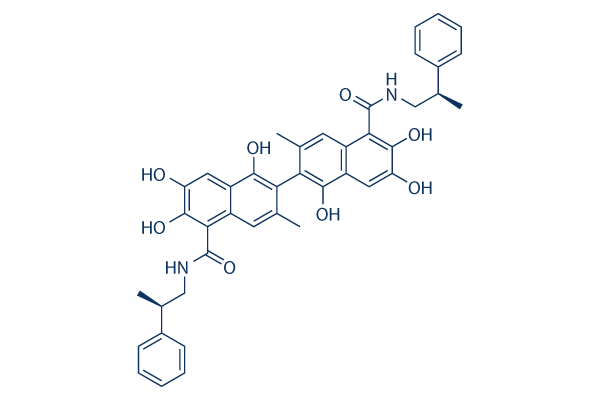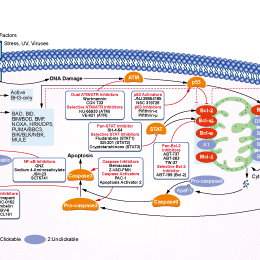
- Bioactive Compounds
- By Signaling Pathways
- PI3K/Akt/mTOR
- Epigenetics
- Methylation
- Immunology & Inflammation
- Protein Tyrosine Kinase
- Angiogenesis
- Apoptosis
- Autophagy
- ER stress & UPR
- JAK/STAT
- MAPK
- Cytoskeletal Signaling
- Cell Cycle
- TGF-beta/Smad
- DNA Damage/DNA Repair
- Compound Libraries
- Popular Compound Libraries
- Customize Library
- Clinical and FDA-approved Related
- Bioactive Compound Libraries
- Inhibitor Related
- Natural Product Related
- Metabolism Related
- Cell Death Related
- By Signaling Pathway
- By Disease
- Anti-infection and Antiviral Related
- Neuronal and Immunology Related
- Fragment and Covalent Related
- FDA-approved Drug Library
- FDA-approved & Passed Phase I Drug Library
- Preclinical/Clinical Compound Library
- Bioactive Compound Library-I
- Bioactive Compound Library-Ⅱ
- Kinase Inhibitor Library
- Express-Pick Library
- Natural Product Library
- Human Endogenous Metabolite Compound Library
- Alkaloid Compound LibraryNew
- Angiogenesis Related compound Library
- Anti-Aging Compound Library
- Anti-alzheimer Disease Compound Library
- Antibiotics compound Library
- Anti-cancer Compound Library
- Anti-cancer Compound Library-Ⅱ
- Anti-cancer Metabolism Compound Library
- Anti-Cardiovascular Disease Compound Library
- Anti-diabetic Compound Library
- Anti-infection Compound Library
- Antioxidant Compound Library
- Anti-parasitic Compound Library
- Antiviral Compound Library
- Apoptosis Compound Library
- Autophagy Compound Library
- Calcium Channel Blocker LibraryNew
- Cambridge Cancer Compound Library
- Carbohydrate Metabolism Compound LibraryNew
- Cell Cycle compound library
- CNS-Penetrant Compound Library
- Covalent Inhibitor Library
- Cytokine Inhibitor LibraryNew
- Cytoskeletal Signaling Pathway Compound Library
- DNA Damage/DNA Repair compound Library
- Drug-like Compound Library
- Endoplasmic Reticulum Stress Compound Library
- Epigenetics Compound Library
- Exosome Secretion Related Compound LibraryNew
- FDA-approved Anticancer Drug LibraryNew
- Ferroptosis Compound Library
- Flavonoid Compound Library
- Fragment Library
- Glutamine Metabolism Compound Library
- Glycolysis Compound Library
- GPCR Compound Library
- Gut Microbial Metabolite Library
- HIF-1 Signaling Pathway Compound Library
- Highly Selective Inhibitor Library
- Histone modification compound library
- HTS Library for Drug Discovery
- Human Hormone Related Compound LibraryNew
- Human Transcription Factor Compound LibraryNew
- Immunology/Inflammation Compound Library
- Inhibitor Library
- Ion Channel Ligand Library
- JAK/STAT compound library
- Lipid Metabolism Compound LibraryNew
- Macrocyclic Compound Library
- MAPK Inhibitor Library
- Medicine Food Homology Compound Library
- Metabolism Compound Library
- Methylation Compound Library
- Mouse Metabolite Compound LibraryNew
- Natural Organic Compound Library
- Neuronal Signaling Compound Library
- NF-κB Signaling Compound Library
- Nucleoside Analogue Library
- Obesity Compound Library
- Oxidative Stress Compound LibraryNew
- Plant Extract Library
- Phenotypic Screening Library
- PI3K/Akt Inhibitor Library
- Protease Inhibitor Library
- Protein-protein Interaction Inhibitor Library
- Pyroptosis Compound Library
- Small Molecule Immuno-Oncology Compound Library
- Mitochondria-Targeted Compound LibraryNew
- Stem Cell Differentiation Compound LibraryNew
- Stem Cell Signaling Compound Library
- Natural Phenol Compound LibraryNew
- Natural Terpenoid Compound LibraryNew
- TGF-beta/Smad compound library
- Traditional Chinese Medicine Library
- Tyrosine Kinase Inhibitor Library
- Ubiquitination Compound Library
-
Cherry Picking
You can personalize your library with chemicals from within Selleck's inventory. Build the right library for your research endeavors by choosing from compounds in all of our available libraries.
Please contact us at [email protected] to customize your library.
You could select:
- Antibodies
- Bioreagents
- qPCR
- 2x SYBR Green qPCR Master Mix
- 2x SYBR Green qPCR Master Mix(Low ROX)
- 2x SYBR Green qPCR Master Mix(High ROX)
- Protein Assay
- Protein A/G Magnetic Beads for IP
- Anti-Flag magnetic beads
- Anti-Flag Affinity Gel
- Anti-Myc magnetic beads
- Anti-HA magnetic beads
- Magnetic Separator
- Poly DYKDDDDK Tag Peptide lyophilized powder
- Protease Inhibitor Cocktail
- Protease Inhibitor Cocktail (EDTA-Free, 100X in DMSO)
- Phosphatase Inhibitor Cocktail (2 Tubes, 100X)
- Cell Biology
- Cell Counting Kit-8 (CCK-8)
- Animal Experiment
- Mouse Direct PCR Kit (For Genotyping)
- New Products
- Contact Us
Sabutoclax
Synonyms: BI-97C1
Sabutoclax (BI-97C1) is a pan-Bcl-2 inhibitor, including Bcl-xL, Bcl-2, Mcl-1 and Bfl-1 with IC50 of 0.31 μM, 0.32 μM, 0.20 μM and 0.62 μM, respectively.

Sabutoclax Chemical Structure
CAS No. 1228108-65-3
Purity & Quality Control
Batch:
Purity:
99.51%
99.51
Sabutoclax Related Products
| Related Targets | Bcl-2 Bcl-B Bcl-w Bcl-xL Mcl-1 Bax Bfl-1 Bad Bcl-xL | Click to Expand |
|---|---|---|
| Related Products | ABT-737 Navitoclax (ABT-263) Obatoclax Mesylate (GX15-070) S63845 A-1210477 TW-37 A-1331852 A-1155463 Dihydrochloride UMI-77 AZD5991 (R)-(-)-Gossypol (AT-101) acetic acid WEHI-539 HA14-1 MIK665 (S64315) Obatoclax (GX15-070) Gambogic Acid Marinopyrrole A (Maritoclax) BAI1 A-1155463 BTSA1 S55746 Ruxotemitide (LTX 315) BAM7 BDA-366 | Click to Expand |
| Related Compound Libraries | Autophagy Compound Library Apoptosis Compound Library Ferroptosis Compound Library Pyroptosis Compound Library Mitochondria-Targeted Compound Library | Click to Expand |
Signaling Pathway
Cell Data
| Cell Lines | Assay Type | Concentration | Incubation Time | Formulation | Activity Description | PMID |
|---|---|---|---|---|---|---|
| human H460 cells | Cytotoxic assay | 3 days | Cytotoxicity against human H460 cells after 3 days by ATP-LITE assay, EC50=0.78 μM | 20443627 | ||
| human PC3 cells | Cytotoxic assay | 3 days | Cytotoxicity against human PC3 cells after 3 days by ATP-LITE assay, EC50=4.64 μM | 20443627 | ||
| MEF | Function assay | 30 μM | 24 h | Induction of apoptosis in MEF expressing wild type Bcl-2 protein at 30 uM after 24 hrs by FITC-conjugated annexin V and propidium iodide staining-based FACS analysis | 20443627 | |
| BP3 | Apoptosis assay | 1 to 2 days | Induction of apoptosis in human BP3 cells after 1 to 2 days by FITC-conjugated annexin V and propidium iodide staining-based FACS analysis, EC50=0.049μM | 20443627 | ||
| M2182 | Antitumor assay | 1 to 5 mg/kg | Antitumor activity against Mcl-1 overexpressing human M2182 cells xenografted in BALB/c mouse assessed as reduction of tumor size at 1 to 5 mg/kg, ip administered 9 times every 2 days | 20443627 | ||
| M2182 | Antitumor assay | 5 mg/kg | Antitumor activity against Mcl-1 overexpressing human M2182 cells xenografted in BALB/c mouse assessed as complete inhibition of tumor growth at 5 mg/kg, ip administered 9 times every 2 days | 20443627 | ||
| Click to View More Cell Line Experimental Data | ||||||
Biological Activity
| Description | Sabutoclax (BI-97C1) is a pan-Bcl-2 inhibitor, including Bcl-xL, Bcl-2, Mcl-1 and Bfl-1 with IC50 of 0.31 μM, 0.32 μM, 0.20 μM and 0.62 μM, respectively. | ||||||||
|---|---|---|---|---|---|---|---|---|---|
| Targets |
|
| In vitro | ||||
| In vitro | BI-97C1 potently inhibits cell growth of human prostate cancer, lung cancer, and lymphoma cell lines with EC50 values of 0.13, 0.56, and 0.049 μM, respectively, and shows little cytotoxicity against bax-/-bak-/- cells[1]. It is suggest that treatment with the combination regimen of mda-7/IL-24 and BI-97C1 induces autophagy that facilitates apoptosis in association with up-regulation of NOXA, accumulation of Bim, and activation of Bax and Bak[2]. |
|||
|---|---|---|---|---|
| Kinase Assay | Competitive fluorescence polarization assays (FPA) | |||
| For competitive binding assays, 100 nM GST-Bcl-XL ΔTM protein is preincubated with the tested compound at varying concentrations in 47.5 μL PBS (pH = 7.4) in 96-well black plates at room temperature for 10 min, and then 2.5 μL of 100 nM FITC-labeled Bak BH3 peptide is added to produce a final volume of 50 μL. The wild-type and mutant Bak BH3 peptides are included in each assay plate as positive and negative controls, respectively. After 30 min incubation at room temperature, the polarization values in millipolarization units are measured at excitation/emission wavelengths of 480/535 nm with a multilabel plate reader. IC50 is determined by fitting the experimental data to a sigmoidal dose-response nonlinear regression model. Data reported are mean of three independent experiments. Performance of Bcl-2 and Mcl-1FPA are similar. Briefly, 50 nM of GST-Bcl-2 or -Mcl-1are incubatedwith various concentrations of compound (4 and 11-14) for 2 min, and then 15 nM FITC-conjugated-Bim BH3 peptide is added in PBS buffer. Fluorescence polarization is measured after 10 min. | ||||
| Cell Research | Cell lines | PC3, H460, H1299 | ||
| Concentrations | ~1 μM | |||
| Incubation Time | 72 h | |||
| Method | ATP-LITE assay |
|||
| In Vivo | ||
| In vivo | BI-97C1 displays in vivo efficacy in transgenic mice in which Bcl-2 is overexpressed in splenic B-cells and also demonstrates superior single-agent antitumor efficacy in a prostate cancer mouse xenograft model that depends on Mcl-1 for survival[1]. Treatment with Ad.5/3-mda-7 and BI-97C1 significantly inhibits the growth of human PC xenografts in nude mice and spontaneously induced PC in Hi-myc transgenic mice. Tumor growth inhibition correlats with increased TUNEL staining and decreased Ki-67 expression in both PC xenografts and prostates of Hi-myc mice[2]. |
|
|---|---|---|
| Animal Research | Animal Models | Bcl-2 transgenic mice, human prostate cancer xenografts |
| Dosages | 1 mg/kg, 3 mg/kg, 5 mg/kg | |
| Administration | intraperitoneally | |
Chemical Information & Solubility
| Molecular Weight | 700.78 | Formula | C42H40N2O8 |
| CAS No. | 1228108-65-3 | SDF | Download Sabutoclax SDF |
| Smiles | CC1=CC2=C(C(=C(C=C2C(=C1C3=C(C4=CC(=C(C(=C4C=C3C)C(=O)NCC(C)C5=CC=CC=C5)O)O)O)O)O)O)C(=O)NCC(C)C6=CC=CC=C6 | ||
| Storage (From the date of receipt) | |||
|
In vitro |
DMSO : 100 mg/mL ( (142.69 mM) Moisture-absorbing DMSO reduces solubility. Please use fresh DMSO.) Ethanol : 26 mg/mL Water : Insoluble |
Molecular Weight Calculator |
|
In vivo Add solvents to the product individually and in order. |
In vivo Formulation Calculator |
||||
Preparing Stock Solutions
Molarity Calculator
In vivo Formulation Calculator (Clear solution)
Step 1: Enter information below (Recommended: An additional animal making an allowance for loss during the experiment)
mg/kg
g
μL
Step 2: Enter the in vivo formulation (This is only the calculator, not formulation. Please contact us first if there is no in vivo formulation at the solubility Section.)
% DMSO
%
% Tween 80
% ddH2O
%DMSO
%
Calculation results:
Working concentration: mg/ml;
Method for preparing DMSO master liquid: mg drug pre-dissolved in μL DMSO ( Master liquid concentration mg/mL, Please contact us first if the concentration exceeds the DMSO solubility of the batch of drug. )
Method for preparing in vivo formulation: Take μL DMSO master liquid, next addμL PEG300, mix and clarify, next addμL Tween 80, mix and clarify, next add μL ddH2O, mix and clarify.
Method for preparing in vivo formulation: Take μL DMSO master liquid, next add μL Corn oil, mix and clarify.
Note: 1. Please make sure the liquid is clear before adding the next solvent.
2. Be sure to add the solvent(s) in order. You must ensure that the solution obtained, in the previous addition, is a clear solution before proceeding to add the next solvent. Physical methods such
as vortex, ultrasound or hot water bath can be used to aid dissolving.
Tech Support
Answers to questions you may have can be found in the inhibitor handling instructions. Topics include how to prepare stock solutions, how to store inhibitors, and issues that need special attention for cell-based assays and animal experiments.
Tel: +1-832-582-8158 Ext:3
If you have any other enquiries, please leave a message.
* Indicates a Required Field
Tags: buy Sabutoclax | Sabutoclax supplier | purchase Sabutoclax | Sabutoclax cost | Sabutoclax manufacturer | order Sabutoclax | Sabutoclax distributor







































